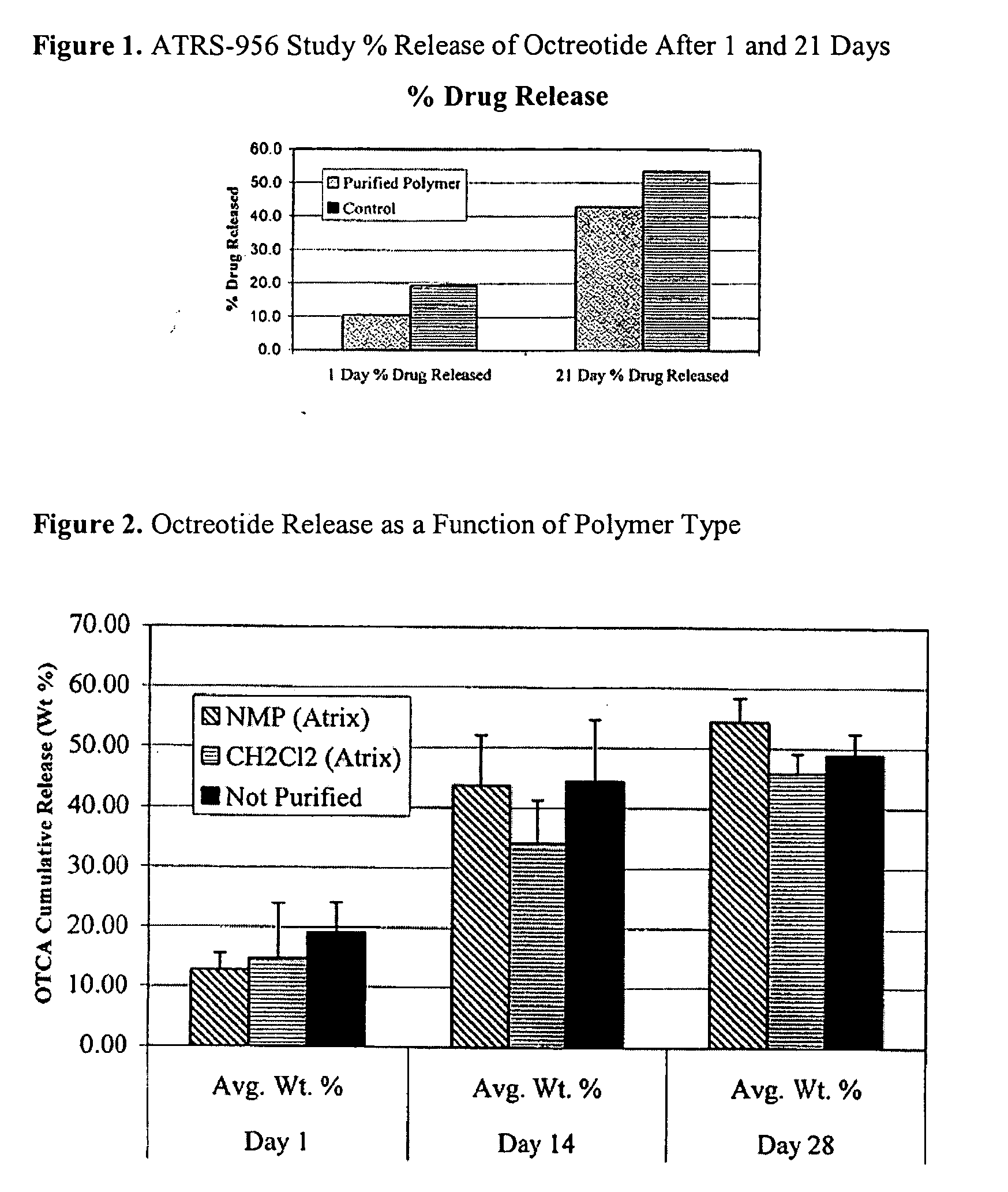Low burst polymers and methods to produce polymer
a polymer and low-burst technology, applied in the field of lactide/glycolide copolymer improvement, to achieve the effect of less acid-catalyzed auto-hydrolysis, lower auto-hydrolysis rate of polymer, and reduced acid content per unit mass
- Summary
- Abstract
- Description
- Claims
- Application Information
AI Technical Summary
Benefits of technology
Problems solved by technology
Method used
Image
Examples
example 1
Purification of acid terminated 85 / 15 poly(DL-lactide-co-glycolide) (85 / 15 PLGH)
[0068]Test articles were prepared with and without the purified copolymer and compared with the starting copolymer (the copolymer prior to carrying out steps of dissolution and precipitation) in a 24 hour release study. The starting copolymer in this Example was an acid-terminated form of poly(DL-lactide-co-glycolide), meaning that one end of the molecular chains making up the copolymer material bear a carboxylic acid group.
[0069]Forty-eight grams of 85 / 15 PLGH with an inherent viscosity of 0.25 dL / g was dissolved in 100 mL of dichloromethane. The polymer solution was poured into a 2 L beaker containing 500 mL of methanol with vigorous stirring. The precipitated polymer formed a soft mass. The dichloromethane-methanol solution was decanted and 200 mL of methanol was added for 5-15 minutes to further extract the dichloromethane. The methanol was decanted from the container and replaced with 100 mL of meth...
example 2
[0077]In Example 2, test depots comprising octreotide as a bioactive agent were prepared from polymers purified by two different methods and compared to a test article prepared from the same polymer in unpurified form, in a 28 day controlled release study in rats.
example 2a
Purification of Polymer in NMP / Water / Ethanol (Control Method)
[0078]A purification technique was developed that involved dissolving the polymer in N-methylpyrrolidone (NMP) and precipitating the polymer solution into a water / ethanol solution. NMP, water, and ethanol can have advantageous properties when used in pharmaceutical preparations compared to dichloromethane (methylene chloride) and methanol.
[0079]The polymer was dissolved in NMP for use in the delivery system. One hundred grams (100 g) of 85 / 15 PLGH was added to 400 g of NMP in a 2 L Nalgene bottle. The bottle was shaken to disperse the polymer and placed on a roll mill overnight to dissolve the polymer.
[0080]A 9.5 L container was equipped with an overhead stirrer set off-center and filled with 4 L of water. With the overhead stirrer at approximately 1250 rpm (Setting 3), the polymer solution was slowly added to the container through a funnel over a 5 minute time period. The resulting polymer suspension was stirred for 30 mi...
PUM
| Property | Measurement | Unit |
|---|---|---|
| weight average molecular weight | aaaaa | aaaaa |
| weight average molecular weight | aaaaa | aaaaa |
| polydispersity index | aaaaa | aaaaa |
Abstract
Description
Claims
Application Information
 Login to View More
Login to View More - R&D
- Intellectual Property
- Life Sciences
- Materials
- Tech Scout
- Unparalleled Data Quality
- Higher Quality Content
- 60% Fewer Hallucinations
Browse by: Latest US Patents, China's latest patents, Technical Efficacy Thesaurus, Application Domain, Technology Topic, Popular Technical Reports.
© 2025 PatSnap. All rights reserved.Legal|Privacy policy|Modern Slavery Act Transparency Statement|Sitemap|About US| Contact US: help@patsnap.com

